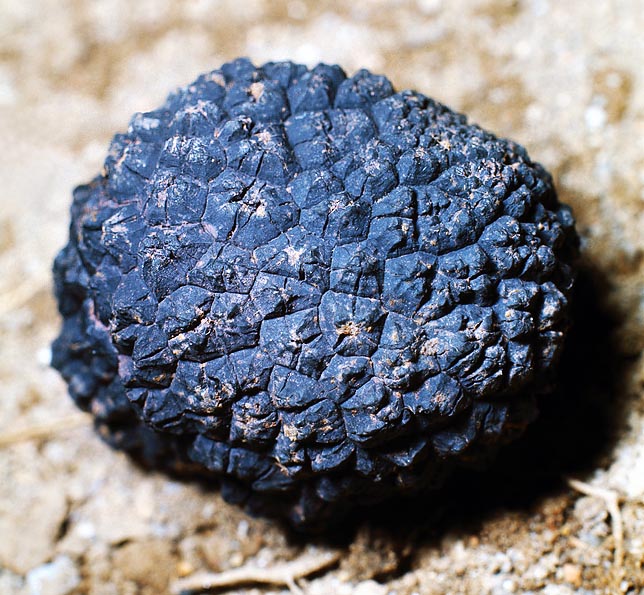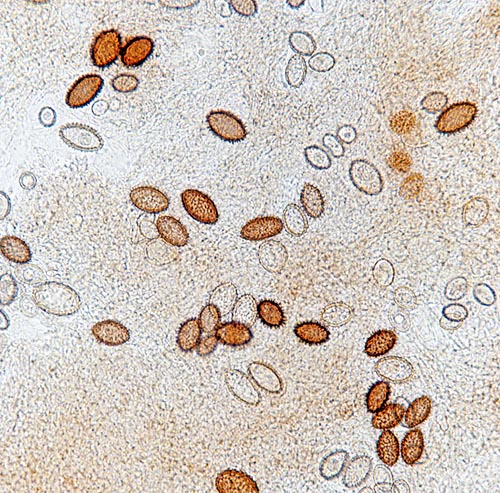
Text © Massimiliano Berretta

English translation by Mario Beltramini

Tuber melanosporum is a prized truffle even if less famous than Tuber magnatum © Giuseppe Mazza
Family: Tuberaceae Dumortier, 1822.
Genus: Tuber Micheli ex Wiggers : E.M. Fries, 1780.
Tuber melanosporum Vittadini, 1831.
From the Greek “mèlas” = black and “sporá” =seed, that which is sown, that is, with black spores.
In Italy, it is currently called “Tartufo nero pregiato”, “Tertufo nero di Norcia e di Spoleto”; in France “Truffe du Périgord”, “Truffe noire”; in Germany “Perigord-Trüffel”; “truffle” in UK.
Description of the genus
Please refer to Tuber magnatum.
Description of the species
Ascocarp: more or less roundish, at times even irregular and lobed, of size varying from 3 to 7 cm, with pyramidal-polygonal warts, 3-5 mm large, with depressed apex, adhering strongly to the black peridium, at times with ferruginous shades, in the immature specimens tending to the wine-red.
Gleba: white when young but soon black-brown tending to the violet or the reddish, with thick and thin whitish venations becoming brown with the age, with well-defined edges and accompanied by two brown bands, translucid on the sides.
Smell: aromatic, particular, not much pungent, pleasant.
Taste: excellent, so much that it is also called sweet black truffle.
Spores: 29-55 × 22-35 µm, elongated elliptic, echinulate, black en masse.

Tuber melanosporum spores seen with microscope © Giuseppe Mazza
Asci: globose, at times with a short peduncle, 90-140 × 80-120 µm, with the surface equipped with short and rigid spines, 2,5-3 µm large, with a density of 1-13 × 10 µm2.
Habitat: symbiotic, hypogeous fungus, it grows in association with broad-leaved-trees (especially with downy oak and holm oak, but also with a hop hornbeam and common hazel), it loves sedimentary soils, usually well drained, like the rubbly and much calcareous ones. Even if it begins to develop in September, it ripens in midwinter, from early December to early March.
Edibility: excellent, it is considered as a prized truffle, by some preferred to more famous Tuber magnatum.
Remarks. It is a species difficult to separate from Tuber brumale, Vittadini himself indicated as distinctive the colour of the gleba, the disposition and the colour of the venations and, chiefly, the smell and the taste; the ripe gleba has a blackish colour tending to the reddish or black-purple.
It can be mistaken with: Tuber brumale Vittadini having the gleba of grey-brown, grey-blackish, colour, run by few wide, cottonous, at times even thin, whitish or beige veins; Tuber brumale var. moschatum (Bull.) I.R. Hall, P.K. Buchanan, Wang & Cole, (1998), having the gleba of beige-hazelnut colour and musky smell, pleasant, delicate and very persistent; Tuber aestivum Vittadini, which has gross warts, hard, pyramidal, pale brown or hazelnut gleba when ripe, with white venations, thin, meandrous, overall smell of leavened flour and pepper, taste of fresh hazelnuts, furthermore, where it grows, it forms the typical small plain, a more or less roundish zone where the grass disappears due to the mycelium itself.
It is probably the most known truffle in the world, it ripens in winter from November to March. It is found in Italy in Umbria, Marche, Tuscany, Emilia Romagna, Lazio and in the most sheltered zone of Veneto, Lombardy, Trentino, Piedmont and Liguria.
It loves the soils derived from the decomposition of the rocks of the Secondary (Mesozoic), with Mediterranean type climate, with sub-alkaline reaction (pH 7,5-8,5) and rich in calcium carbonate, as is the case, anyway, for the Tuber magnatum Pico.
→ For general notions about Fungi please click here.
→ To appreciate the biodiversity of MUSHROOMS please click here.
